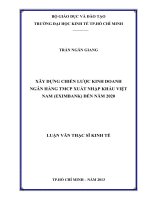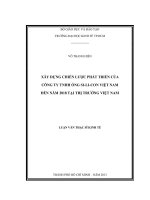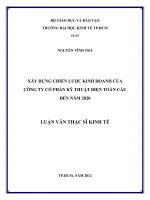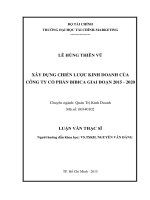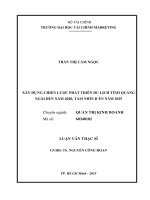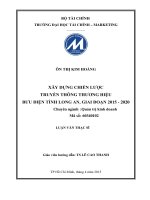(Luận văn thạc sĩ) xây dựng chiến lược marketing tại trung tâm kỹ thuật và tư vấn tài nguyên nước
Bạn đang xem bản rút gọn của tài liệu. Xem và tải ngay bản đầy đủ của tài liệu tại đây (1.51 MB, 96 trang )
ĐẠI HỌC QUỐC GIA HÀ NỘI
KHOA QUẢN TRỊ VÀ KINH DOANH
---------------------
ĐỖ VIỆT HÀ
ESTABLISH MARKETING STRATEGIES AT CENTER FOR
WATER RESOURCES TECHNICAL AND CONSULTANT
XÂY DỰNG CHIẾN LƯỢC MARKETING
TẠI TRUNG TÂM KỸ THUẬT VÀ TƯ VẤN TÀI NGUYÊN NƯỚC
LUẬN VĂN THẠC SĨ QUẢN TRỊ KINH DOANH
HÀ NỘI - 2019
ĐẠI HỌC QUỐC GIA HÀ NỘI
KHOA QUẢN TRỊ VÀ KINH DOANH
---------------------
ĐỖ VIỆT HÀ
ESTABLISH MARKETING STRATEGIES AT CENTER FOR
WATER RESOURCES TECHNICAL AND CONSULTANT
XÂY DỰNG CHIẾN LƯỢC MARKETING
TẠI TRUNG TÂM KỸ THUẬT VÀ TƯ VẤN TÀI NGUYÊN NƯỚC
Chuyên ngành: Quản trị kinh doanh
Mã số: 60 34 01 02
LUẬN VĂN THẠC SĨ QUẢN TRỊ KINH DOANH
NGƯỜI HƯỚNG DẪN KHOA HỌC: TS. PHẠM VĂN HỒNG
HÀ NỘI - 2019
DECLARATION
The author confirms that the research outcome in the thesis is the
result of author’s independent work during study and research period and it is
not yet published in other’s research and article.
The other’s research result and documentation (extraction, table,
figure, formula,
and other document) used in the thesis are cited properly
and the permission (if required) is given.
The author is responsible in front of the Thesis Assessment
Committee, Hanoi School of Business and Management, and the laws for
above-mentioned declaration.
Date…………………………..
i
ACKNOWLEDGEMENTS
I would like to express my deepest gratitude to all of the following
people for helping me complete my thesis.
Firstly, I would like to express my special thanks to my company for
giving favorable conditions for my study and my master thesis completion at
Hanoi school of business and management (HSB).
Secondly, I am extremely grateful to all of the lecturers from the
Department of Business Administration - HSB for providing me with
research methods and professional knowledge during the course, especially
the active and creative research skills.
My appreciation also goes to the teachers in the thesis review committee
for giving me valuable ideas during my thesis completion process.
My profound gratitude is also conveyed to my instructor for his helpful
assistance and guidance. This thesis could have never been completed
without his enthusiastic counsel and support.
Despite the efforts during the research period, there are still many
limitations in the thesis. I would hope to receive valuable comments from the
teachers and co-workers to make this essay more complete.
Thank you very much./.
Ha Noi,
ii
2019
INDEX
DECLARATION ..............................................................................................I
ACKNOWLEDGEMENTS........................................................................... II
INDEX ........................................................................................................... III
LIST OF TABLES ...................................................................................... VII
LIST OF FIGURES AND CHARTS ........................................................VIII
INTRODUCTION ........................................................................................... 1
1.Urgency of the subject ................................................................................. 1
2. Overview of research situation .................................................................. 3
3. Research objectives ..................................................................................... 5
4. Research subjects ........................................................................................ 5
5. Research scope ............................................................................................. 6
6. Research Methodology................................................................................ 6
7. Structure of the thesis ................................................................................. 6
CHAPTER 1. RATIONALE OF MARKETING STRATEGY
DEVELOPMENT ........................................................................................... 7
iii
1.1 Basic Definition of Marketing and Marketing Strategy........................ 7
1.1.1 Definition of Marketing ......................................................................... 7
1.1.2 Marketing Strategy ................................................................................ 8
1.1.3 Role, importance of marketing and marketing strategy .................... 8
1.2. Content Of Marketing Strategy ............................................................ 10
1.2.1 Research models ................................................................................... 10
1.2.2. Product Strategy.................................................................................. 11
1.2.3. Product price strategy ........................................................................ 15
1.2.4. Distribution strategy ........................................................................... 18
1.2.5. Promotion Mix Strategy ..................................................................... 19
1.3 Procedure of Marketing Strategy Development .................................. 21
1.3.1 Setting Marketing goals ....................................................................... 21
1.3.2 Macro-environmental analysis............................................................ 21
1.3.3 Sector environment .............................................................................. 22
1.3.4 Matrix evaluating external factors (EFE).......................................... 25
1.3.5 Micro-environment analysis................................................................ 26
1.3.4 Develop Marketing strategy with SWOT matrix.............................. 28
CHAPTER 2. ACTUAL SITUATION OF MARKETING STRATEGY
AT CENTER FOR WATER RESOURCES TECHNICAL AND
CONSULTANT ............................................................................................. 31
2.1. Introduction of Center for water resources technical and consultant
......................................................................................................................... 31
2.1.1. General information............................................................................ 31
2.1.2. Organizational chart ........................................................................... 32
2.1.3. Function, duties ................................................................................... 33
2.1.4. Manufacturing and business status of the company........................ 35
2.2. Analysis of the marketing environment at the Center for Water
Resources Technical and Consultant .......................................................... 36
iv
2.2.1 Macro-environmental analysis............................................................ 36
2.2.2 Sectoral Environmental Analysis ....................................................... 43
2.2.3 Micro environment.............................................................................. 51
2.3.4 Research and development capacity .................................................. 57
2.3.5 IFE matrix............................................................................................. 58
2.3 Analysis of the actual marketing strategy situation of the Center ..... 60
2.3.1 Product strategu ................................................................................... 60
2.3.2 Price strategy ........................................................................................ 61
2.3.3. Distribution strategy ........................................................................... 61
2.3.4 Mixed promotion strategy ................................................................... 62
2.4 Evaluation of actual situation of marketing strategy of the Center for
Water Resources Technical and Consultant .............................................. 63
2.4.1 Achievement.......................................................................................... 63
2.4.2 Limitations ............................................................................................ 64
CHAPTER 3. PROPOSAL OF MARKETING STRATEGY FOR THE
CENTER FOR WATER RESOURCES TECHNICAL AND
CONSULTANT
3.1. Development orientation of the Center for Water Resources
Technical and Consultant by 2025 .............................................................. 65
3.2. Proposal of marketing development for the Center for Water
Resources Technical and Consultant by 2025 ............................................ 66
3.2.1 Proposal of marketing development for the Center for Water
Resources Technical and Consultant by 2025 ............................................ 66
3.2.2 Strategy implementation method ....................................................... 69
3.3. Some recommendations to the State..................................................... 80
3.3.1. Renovate the financial mechanism of the State capital management
......................................................................................................................... 80
3.3.2. Improve incentive policies for the employees ................................... 81
v
3.3.3. There should be a clear policy of the relationship between the State
and the organization ..................................................................................... 81
CONCLUSION .............................................................................................. 83
REFERENCE DOCUMENT ....................................................................... 85
vi
LIST OF TABLES
Table 1.1 : Product status and appropriate promotion strategies .................... 20
Table 1.2: EFE matrix summary table ............................................................ 25
Table 1.3: IFE summary table ......................................................................... 28
Table 1.4: SWOT matrix model ...................................................................... 30
Table 2.1: Manufacturing and business status of the Center .......................... 35
Table 2.2: Some Regulations on Environmental and Water resource protection
......................................................................................................................... 39
Table 2.3: Number of the customers of the Center annually .......................... 47
Table 2.4: EFE matrix synthesis ..................................................................... 50
Table 2.5: Human resources of the Center ...................................................... 51
Table 2.5: Machinery system .......................................................................... 56
Table 2.6: IFE matrix ...................................................................................... 58
Table 2.7: Some products and services provided by the Center ..................... 60
Table 3.1: SWOT matrix synthesis ................................................................. 67
Table 3.1: Estimated budget for strategy implementation .............................. 76
vii
LIST OF FIGURES AND CHARTS
Chart 1.1: 5 competitive pressure model ........................................................ 23
Diagram 2.1: Number of industrial zones in Vietnam at the present ............. 37
Diagram 2.2: Number of current competitors in the market of the Center ..... 44
Diagram 2.2: Organize the project implementation site of the Center ........... 54
Image 2.1: Equipment, tools for analysis, research and development ............ 58
Diagram 2.3: Marketing activity of the Center ............................................... 63
Diagram 3.1: Organizatoin chart of the expense mangement division ........... 73
Image 3.1: Some construction equipment ....................................................... 77
Image 3.2: Specialized machinery .................................................................. 78
viii
INTRODUCTION
1.Urgency of the subject
Water resource is the foundation and development of society, playing an
essential and vital role to human life. In the globalized world, with climate
change and environmental pollution in general and water resources in
particular, water pollution, degradation have been the global issues, common
concerns of the whole human race. Therefore, water resource is really
important and indispensable to every citizen, business, country and is subject
to dispute in many parts of the world. For that reason, the Ministry of Natural
Resources and Environment has promulgated the Decision No. 1168 / QDBTNMT, establishing the units under the Ministry, including the Center for
Water Resources Technical and Consultant; The Center for Water Resources
Engineering and Consultancy is a public non-business unit of the National
Center for Water Resources Planning and Investigation (NAWAPI) under the
Ministry of Natural Resources and Environment, having the function of
building, managing and deploying techniques and technologies on planning,
investigation, protection, exploitation and use of water resources; providing
and consulting public services on water resources for domestic and foreign
organizations and individuals according to the provisions of law;
Based on the sustainable development orientation of Vietnam in the 21st
century, the 2011-2020 socio-economic development strategy appreciates the
role of water resources, considering water resource as an important and
strategic resource.
In recent years, the economy of our country has seen positive changes.
However, through objective assessment, it can be been that the public debt of
our country has reached a high level, politics and domestic and foreign market
economy remain many complicated developments; The Party and the
Government have promulgated Decision to cut down the staff and limitation
1
of public expenditure policies. Especially the Government requests the
ministries and branches to advocate equitisation of SOEs (State Owned
Enterprises), Public non-business units, organize bidding of the projects and
schemes using state budget funds in a public and democratic way; As a result,
the competitive market in all sectors will occur. Especially, the units under the
Ministry using the state budget to maintain and survive so far will be
gradually eliminated.
As a matter of fact, it is really important for the Center for Water
Resources Technical and Consultant to develop marking strategies by 2020
with a vision of 2030 in order to remain the position with its competitive
capacity. This is very urgent and suitable with the development trend of the
industry and the market in Vietnam.
To meet above-mentioned needs, according to the assigned functions and
tasks, the Center for Water Resources Technical and Consultant shall develop
marking strategies by 2020 with a vision of 2030 for the development and
promotion of the brand names and new technology products with high quality
to the domestic and foreign market, from which building the marketing
strategies suitable with the competitive and international integration market
economy. Development of marketing strategies will be the guideline for all
activities of the Center, aiming to the objective of becoming a prestigious and
growing unit in the competitive by 2030 in the domestic competitive and
international integration market in the field of water resources, "keeping pace
with the big Groups, Corporations in the region and being asymptotical with
the international reputation Groups and Companies.
From above perceptions and urgent requirements, the author selected the
topic “Develop marketing strategy at the Center for water resources technical
and consultant” as a research topic for master thesis.
2
3.
2. Overview of research situation
Building an effective marketing strategy is really important for all
enterprieses. A business plan will orient the company to develop while the
marketing plan will help the company know how to implement that business
plan by creating a relationship with the customer step by step. There have
been many studies related to the development of marketing strategies of the
enterprises, organizations as follows:
+ Master’s thesis on Business Administration thesis on "Building
business strategy of Dong Hai Joint Stock Company of Ben Tre in the period
of 2015-2020" by Luu Vinh Hao (2014). In this study, the author combined
the theory and practice of the company to develop a business strategy for
Dong Hai Joint Stock Company of Ben Tre and suggest solutions to meet the
company's strategy in the period 2015-2020.
+ Master’s thesis on Business Administration thesis on "Building
business strategy at Hanoi Synthetic Paint Joint Stock Company in the period
of 2013-2017" by Nguyen Thi Tuyet Nhung (2013). This thesis focused on
studying the business environment and the actual situation of Hanoi Synthetic
Paint Joint Stock Company, from which building the business strategy for the
company. Business strategy is oriented and outlines ways to help build a
concrete plan to achieve the desired effect.
The thesis used statistical analysis and synthetic analytical methods,
from which assessing actual manufacturing and exporting situation of the
enterprise. The author summarized environmental factors and identified
strategic opportunities. On the basis of applying theory and rationale to set
appropriate business strategy.
Master’s thesis on Business Administration thesis on "Building business
strategy at Vietnam Dairy Products Joint Stock Company (Vinamilk) in the
3
period of 2017-2025" by Nguyen Ba Cuong (2016). The research has assessed
the overall situation of production and business of Vinamilk, found out
advantages, weaknesses, opportunities and threats. From that, the author has
developed the business strategy of the company until 2025. In this research,
the author has applied the learned knowledge into real practice for the most
effective development of business strategy for the company.
Research on "Building business strategy of Truong Son Construction
Corporation till 2020" by Nguyen Hai Son (2014), Finance Magazine No. 3 2014. Truong Son Construction Corporation (Army Corps 12 - The Ministry
of Defense), a unit to succeed the tradition of Truong Son Army Corps - Ho
Chi Minh Trail - A legendary trail, founded on 19th May 1989. As a large
state-owned enterprise in the construction industry, in the centralized,
bureaucratic and State-subsidized mechanism, the enterprise is also
dominated by bureaucratic mandates. Due to the dependence on the State and
the Ministry of Defense, the unit has been lacking for flexibility in developing
business strategy and orientation for business development and remaining
passive in dealing with employment. Therefore, the research plays an
important role in helping the Corporation to strategically and effectively
implement its business activities.
Tran Thi Anh Tuyet (2016) conducted the research on "Developing
marketing Strategy for Haiha-Kotobuki Joint Venture Company Limited in
the period of 2017-2020". In the study, the author gave an overview of the
theory of strategic management and built marketing strategy, carried out
analysis of marketing environment, built SWOT matrix for the marketing
strategy, analyzed and selected target markets, defined marketing objectives,
built marketing strategy and developed action plan for the marketing plan
based on the research results of the company.
4
Nguyen Van Dung (2015) conducted a research on "Building Marketing
Strategies at Duc Tran Co., Ltd". The purpose of the study is to systematize
theories of marketing strategy and actual situation of the enterprise, analyzed
the basis of marketing strategy for Duc Tran Co., Ltd, from which giving
proposals for marketing strategy suitable with the company's development
goals in the period of 2015-2020. Key contributions of the research include
clarifying systematize the theoretical issues on developing marketing
strategies in the enterprise, analyzing the basis to develop marketing strategies
at Duc Tran Company, suggesting marketing strategies at Duc Tran Co., Ltd
in the period of 2015-2020.
Pham Thuy Hong (PhD Thesis in 2011), in her thesis of "Developing
Competitive Strategy for Vietnamese SOEs", has outlined the competitive
strategies for SOEs but has not yet come to specific conclusion and strategic
methodology in terms of development of business strategy as well as
marketing strategy.
There have been a lot of projects on building marketing strategies for the
enterprises but there has been no research on "Developing marketing
strategies at the Water Resources Technical and Consultant". Thus, scope of
research space and time of the thesis is not coincided with published works.
3. Research objectives
- Systematize the theoretical issues of marketing strategy
- Analyze actual situation of the development of marketing strategy at
the Center for Water Resources Technical and Consultant.
- Propose marketing strategy for the Center for Water Resources
Technical and Consultant
4. Research subjects
Theoretical and practical issues on developing marketing strategy at the
Center for Water Resources Technical and Consultant
5
5. Research scope
Scope of content: Study the basic contents to build the marketing
strategy for the state unit in the context of the current market economy.
Scope of space: At the Center for Water Resources Technical and
Consultant
Scope of time: Collected survey data from 2015 - 2017
6. Research Methodology
6.1. Data collection methods
Secondary data is collected from sources: Ministry of Planning and
Investment, Center for water resources technical and consultant in order to
collect the factors affecting the internal environment and the external
environment affecting develop marketing strategy at the Center for water
resources technical and consultant
Primary data is collected by investigating the experts work at Center for
water resources technical and consultant to build EFE matrix synthesisa and
IFE matrix synthesis. Thereby, The author draw level reaction center for
water resources technical and consultant with the environment. The number
of experts that the author surveyed is 20 people.
6.2. Method of processing data
Data after collection will be processed and calculated by Excel software
for statistics in the form of tables. Thereby, the author will easily analyze and
evaluate.
7. Structure of the thesis
The thesis is divided into 03 chapters with the titles of each chapter as
follows:
Chapter 1: Rationale of Marketing Strategy Development
Chapter 2: Actual Situation of Marketing Strategy at Center for Water
Resources Technical and Consultant
6
Chapter 3: Proposal of Marketing Strategy for the Center for Water
Resources Technical and Consultant
CHAPTER 1. RATIONALE OF MARKETING STRATEGY
DEVELOPMENT
1.1 Basic Definition of Marketing and Marketing Strategy
1.1.1 Definition of Marketing
According to Phillip Kotler, “ Marketing is human activity directed at
satisfying needs and wants through exchange processes”.
According to Chartered Institute of Marketing, “Marketing is the process
of planning and executing the business from detecting and transferring
purchasing power of the customers into real demand on a specific good to
producing and giving the products to the final consumers in order to bring
expected profit to the company”.
According to AMA’s definition, “Marketing is the process of planning
and executing the conception, pricing, promotion and distribution of ideas,
goods and services to create exchanges that satisfy individual and
organizational objectives
According to I. Ansoff, a marketing expert from the United Nations,
“Marketing is the science operating the entire business from manufacturing to
consumption, basing on fluctuation demand of the market or in orther words,
focusing on market as an orientation”. This concept is considered as an
7
adequate perception, presenting modern marketing mind by many researchers
and is widely accepted.
1.1.2 Marketing Strategy
In order to do business efficiently, increase competitiveness and
optimize profits, the enterprises should conduct information surveys on
consumer demand with their products as well as their competitors market
potential. Basing on collected information, the enterprises conduct market
segmentation, select key markets and combine marketing tools. Through
setting marketing strategy, the activities of an enterprise are conducted in an
oriented procedure appropriate to the market characteristics of the business.
Marketing strategy of the business can be understood as follows:
“Marketing strategy is a logical, logical argument, being basis for a unit
to solve its marketing tasks. Marketing strategies include specific strategies
for each target market and each customer segment." (Philip Kotler)
Marketing strategy is the systematically comprehensive combination
between mixed Marketing and key market. Mixed marketing parameters are
developed and targeted to a specific customer group (target market).
Marketing Mix is a set of variables that the business can control and
manage. The components of Marketing Mix include: product, price,
distribution and promotion strategy.
Thus, Marketing is the is the outline of how businesses allocate
resources to achieve business goals, exploit and utilize current strengths and
competitive tools. They can be products, service, personnel or image of the
business. And through the coordination of price fixing, advertising, product
design and distribution activities, the company can achieve a dominant
position in compared with other competitors, persuading the related parties
and at the same time orienting the product to reach the target.
1.1.3 Role, importance of marketing and marketing strategy
8
In business, marketing as well as marketing strategy plays a very
important role. Marketing is a bridge between buyers and sellers, helping the
sellers understand the true needs of the buyers and satisfy them in the best
way. Based on the objectives of the organization, management members will
develop a relevant marketing program that includes analysis of marketing
opportunities, research and selection of target markets, marketing strategies,
marketing plans and execution and testing of marketing efforts.
+ Marketing and marketing strategies are utilized to solve basic
economic problems of business, including:
Firstly, identify
type of product that the company needs to supply
the market.
Secondly, arrange product delivery processs carefully with the
simultaneous participation of the three elements of technical including
infrastructure, direct staffs and customers.
Thirdly, the handle harmoniously of beneficial relationships among the
customers, employees and management side.
Addressing these issues will help to motivate the operation of the
business, from which maintaining and developing the relationship between
the business and customers.
+ Marketing and marketing strategy become the bridge connecting the
operation of the business to the market.
One of the important tasks of marketing is to create a competitive position
in the market. The process of creating a competitive position of the business is
closely related to the development of the products in the target market.
Specifically, Marketing and Marketing Strategies have the following roles:
First, create the uniqueness of the product.
Second, clarify the importance of the distinction to the guest
9
Third, create the ability to maintain the advantage of the distinction of
the business
Through identifying and maintaining the advantages of the distinction,
marketing and marketing strategies help the businesses develop day by day
and improve their competitive position in the marketplace.
The importance of marketing strategy in the enterprise
To survive and develop, the businesses need to set business goals and try
to achieve those goals. When managing work based on experience, intuition
can not guarantee success, strategic planning for all business activities is
essential. The strategic plan will help the business better understand its goals
and direct the coordination of the activities more perfectly. Strategic planning
helps the managers to think about business issues systematically, bringing
about positive changes.
As part of the overall strategy of the business, the marketing strategy
demonstrates the entrepreneurial endeavor to achieve a desirable position on
the competitive position and the fluctuation of the business environment.
Only when the marketing strategy is set up can the entrepreneur's marketing
activities begin synchronously. Marketing activities begin from studying,
identifying internal and external factors, evaluating internal condition, from
which developing policies on products, pricing, distribution and promotion to
achieve the intended goal.
Thus, marketing strategy is an important tool that every business needs
to build. This is the first job to develop a marketing program of the business,
serving as a basis for organizing and implementing other activities in
corporate governance in general and marketing management in particular.
1.2. Content Of Marketing Strategy
1.2.1 Research models
10
The thesis approached researching under 4P marketing model which is
commonly used in the enterprises. Accordingly, 4P research model includes
the following strategic content: Product strategy; Price strategy; Distribution
strategy and promotion strategy
Image 1.1 : Research model of the thesis
Product strategy
Price strategy
Marketing strategy
Distribution strategy
Promotion strategy
The specific content of the strategies in the research model is presented
as below
1.2.2. Product Strategy
* Product definition
- According to traditional point of view, a product is a synthesis of
observable physical and chemical properties in a uniform manner and usable
thing. In the field of manufacturing, the product contains two attributes,
including value and using value.
- According to Marketing point of view, A product is anything that can
be marketed to create attention, procurement, use, consumption for the purpoe
of satisfying a request or desire. They can range from objects, services,
people, places, organization to ideas, etc.
Today, consumers who buy a product pay attention to not only using
value but also many other aspects of the product such as elegance,
convenience and fashionability.
11
Thus, understanding of products from the perspective of marketing is
more broad, helping businesses to research the product, from which outlining
more complete and effective strategy.
* Components of the product
- Core Part of the Product answers the question "What do the buyers
really want to buy?". Consumers are often interested in certain benefits of
each product. This is the product on the idea.
- Realization Part of the Product is the basic form of the product,
including 5 elements such as characteristics, labels, packaging, quality, design
of the product.
- Supplemental Part of the Product in cludes additional services and
benefits that distinguish it from the competitor's product. It includes
accessories, service places, after-sales service, warranty, delivery
* Product strategies
In the increasingly competitive conditions along with the development
of science and technology and information systems, besides price factor,
customers also pay attention to other factors such as quality, design, service.
In addition, according to the current business trend, the enterprises not only
try to meet customers’ demands but also aim to orient and stimulate demands.
More specifically, they produce the products that go ahead of existing needs.
Meanwhile, Marketing must determine what to produce, how to produce
and how to sell the products. That’s why the product strategy is the foundation
and the first step in the production and business process, requiring the enterprises
to have creative mind and sophisticated observation, not only aiming current
market but also predicting future market, from which offering market with the
products meeting the rich and constantly changing needs of customers.
Product strategy is quite broad and includes following main directions
+ Category strategy
12
Since the market is always changing with time, space, gender, age,
occupation, income, a business can not develop stably and sustainably with only
one type of product since it will be very difficult to avoid the risk. Therefore, the
enterprises must have a reasonable product category strategy, including
- Product Brand Repositioning Strategy : No matter how well a product
has been positioned in the market, the manufacturer must reposition it for a
while. Competitors may have launched an identical product and encroached
on the market share of the company. Either the taste of the customer has
changed or the product is no longer suitable with the taste of the consumer.
Repositioning may require a change of both the product and its image or
only the image of the product. When repositioning a product brand, the
marketers must make sure that the product's new location remains consistent
with the original location. By this way, the business can retain their old
customers while attracting more new customers in order to maintain and
develop the existing market.
- Strategy of expanding or cutting product types : Brand expansion
strategies are efforts to use a successful brand name to launch new or
innovative products. Expanding the brand name helps the enterprise to save
fees for advertising new brand name.At the same time, the new product is
rapidly accepted by the market.
In contrast, during the business, feedbacks from the market helps the
businesses to identify products being preferred by consumers and the products to
be eliminated. From which, the enterprises can decide to cut down ineffective
products, saving resources to focus on developing effective products.
- Product modification strategy : Product modification allows the
emanufacturers not to produce entirely new products. Businesses can create a
new product on the basis of modifying the existing products. The modification
strategy also includes improvements in shape, materials, decoration, packaging,
13
etc. In many cases, the technical characteristics of the product still remain the
same while only the change in packaging can also bring the manufacturers
opportunities of large consumption such as some canned products.
+ Strategy on product quality
There are three kinds of product quality strategy:
- Strategy to improve product quality: This strategy is implemented in
technical aspects of the product, including improving the parameters of
durability, safety, life of the product ; changing the style, size ; paying special
attention to the color, taste of the product; changing fabrication materials;
limitting or removing deffective components or the component less relevant
to the public; replacing with the components appropriate to the customers;
enhancing the application of goods such as easy to use, easy to maintain, easy
to buy spare parts ...
- Strategy to maintain product quality: Many companies maintain the
original quality of the product unless there are obvious mistakes or new tastes
requiring changes.
- Strategy to gradually reduce the quality: Some companies initially
introduced new products with very good quality. After resonating and
occupying a significant market share, they begin to reduce quality to
compensate for higher costs with the hope that buyers do not recognize the
difference. This might help to increase current profit but will inevitably affect
long-term profitability.
- Strategy to diversify or innovate the product : This strategy aims at
developing new products for current market or developing new products for
new markets. In general, during the development phase of the enterprises,
renewal of product categories make the volume of consumption increase,
helping the enterprises to improve their market share in current market and
attack new segments of the market or expand other markets. This strategy also
14
extends the ability to meet the different needs of the consumers, limiting the
rapid deterioration of the product.
The essence of the product strategy is to the flexiility, quick response
and timely decisions, ensuring that new products are always availble in case
the market is stagnating.
1.2.3. Product price strategy
Price is an indispensable factor in the marketing strategy of the business.
For the consumers, price plays a decisive role in buying this product or
another product. As for businesses, prices are particularly important in the
reproduction process because it is the last stage that reflects the results of
other stages. There are many factors that affect price decisions such as
- Internal factors: Based on the strategy, target of the company on the
direction of activities such as marketing, pricing, distribution methods ...
- External factors: Business environment, competitiveness of the
competitors, alternative products, demand and supply capacity.
* Product pricing methods
- Cost-plus pricing: This is the simplest method in which the company
adds a standard markup to the cost of the product. The profit margin varies by
product type.
- Target profit pricing: This pricing method is based on break-even
analysis. With this pricing method, the manufacturer must consider different
prices and estimate the breakeven output, possibility of demands and the
profitability of the product unit to determine the feasibility of the target profit.
.
- Buyer-based pricing: This is the method of pricing according to the
customer perception of the product in stead of the cost of the manufacturer.
Customer perceptions of the value are the key to this pricing method.
15




